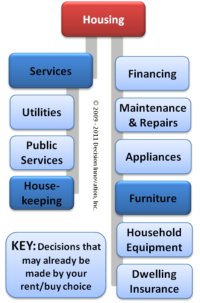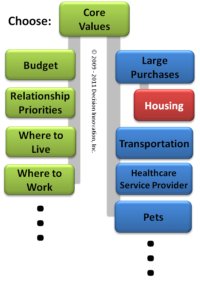Housing decisions - Using the Consumer Expenditure Survey to reveal related spending decisions
Building on the work from our overview of consumer choices, we can take a closer look at housing decisions by focusing on the spending associated with housing. The decision network image below shows the decisions that are related to choosing your home based on the information from the Consumer Expenditure Survey (CES).
Choosing to own or rent

Choosing your home constitutes the largest expenditure under housing, and consumes almost 60% of the spending on average. This includes expenses for owned dwellings (61.2%), rented dwellings (32.2%), and other lodging (6.6%). Digging into the survey a little deeper reveals that other lodging includes vacation lodging, such as hotels, motels, or a vacation home.
This breakdown suggests a key criterion in addition to cost for the shelter housing decision: expected length of stay. Choosing to own or rent is often guided by the expectation of how long one plans to stay at a particular shelter. This also applies to the choice for vacation lodging.
Choosing to own also brings a related decision for financing that renting does not require, in addition to the consequences of bearing the costs for property taxes, maintenance, repairs, and insurance that are often included in rent. When evaluating costs in the own versus rent decision, be sure to include these expenses in the evaluation.
Housing decisions that may be included in the choice for shelter

So far we have only accounted for 61% of the spending for housing. Where does the remaining 39% of housing costs get used? Again, the survey exposes some connected decisions or consequences from choosing your home.
On average 21.6% of the housing expense is for utilities and public services such as natural gas, electricity, fuel oil, water, sewage treatment, and possibly garbage collection. Community or government regulations will often constrain these decisions as an outcome of the housing location. This infers the need to include them as part of the housing decision evaluation. These expenses also track with overall increases for shelter associated with increased income. This adds additional motivation to include these additional housing expenses when considering the choice for shelter.
Some additional items categorized under housing suggest other decisions that may be included or constrained by the choice of housing. These include:
- Personal services such as yard maintenance or snow removal
- Housekeeping supplies
- Furniture
- Major appliances
- Household equipment for heating, cooling, and water processing (heating, softening, purification, well pump, ...)
Related decisions
 Looking at some of the other spending categories in the CES suggests additional connected decisions that may be related to choosing your home. Examples include decisions for:
Looking at some of the other spending categories in the CES suggests additional connected decisions that may be related to choosing your home. Examples include decisions for:
- Transportation - City, suburban, or rural location will impact your transportation needs as well as availability and access to public transportation.
- Pets - The ability to have pets can be severely limited in the case of choosing to rent. Also, home owner association agreements or community ordinances can also limit pet choices.
- Healthcare and service providers - Easy access to specific services and providers will be constrained by housing location. This can be particularly true for rural locations where population densities tend to reduce the number of available providers.
Connected personal decisions of where to live, where to work, relationship priorities, core values and budget may also provide strong guidance for your housing decisions.
What does this all mean?
Housing choices consume about one third of the yearly average spending in the United States based on the data available from the Consumer Expenditure Survey. Looking at some of the details in the survey, we are able to identify many of the related decisions that will be included or constrained by the choice of housing as shown in the housing decision network.
Using this connected decision network when making housing decisions can help prevent being surprised by unintended consequences after housing choices are made. The information in the CES can also be helpful in providing guidance to budgeting for many common consumer spending items.

